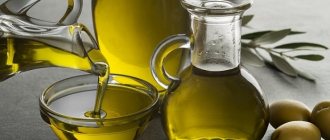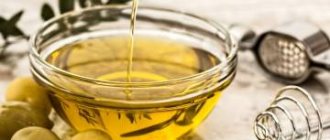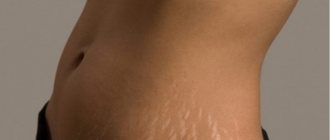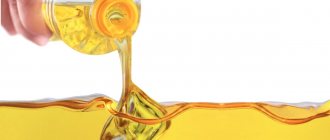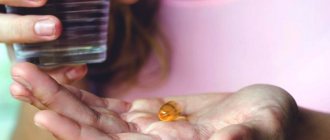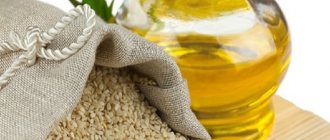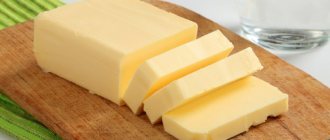Pregnancy is a time of anxiety and worry (especially if this is the first time). How many different questions arise at this time! And one of them: how to avoid or at least minimize the appearance of such a cosmetic skin defect as stretch marks? Is it possible to make this natural process of stretching the skin as unnoticeable as possible (after all, you don’t want to lose your former attractiveness!), especially since for some these “scars” are almost invisible (white or pink), while for others they are simply frighteningly bluish. purple? What to do if many of the remedies available in everyday “normal” life are undesirable or even contraindicated during pregnancy?
Olive oil will help cope with such an unattractive consequence of pregnancy.
What are stretch marks and why do they appear during pregnancy?
During pregnancy, the expectant mother's body undergoes significant changes: in particular, the abdomen and breasts increase. As the volume of the body increases, the skin stretches. If there is no decrease in the level of collagen and elastin, the skin successfully adapts to the new conditions. If the amount of collagen and elastin nevertheless decreases for certain reasons (genetic predisposition to the formation of stretch marks, the presence of endocrine disorders, rapid weight changes, the presence of sharp fluctuations in hormonal levels), stretching or rupture of collagen and elastic fibers occurs. As a result, striae appear on the surface of the skin - scar formations. Usually they are located longitudinally (less often transversely), parallel to each other.
Striae do not pose any danger to the health of the expectant mother, but they are a cosmetic defect. Depending on their number and color, stretch marks can be either subtle or pronounced. They are usually localized in those areas of the body where the skin is subject to the greatest stretch. During pregnancy, such areas become the abdomen, chest, and less commonly, the hips and buttocks. The width of the striae ranges from 1 to 5 mm, the length from 0.5 to 10 cm. The color varies from flesh-pearl (almost imperceptible) to dark pink, bluish and purple.
Why do stretch marks appear during pregnancy?
It would seem that the skin is a fairly elastic and elastic “material,” but during pregnancy (or with rapid weight gain), stretch marks form on it (striae is the medical name for this aesthetic skin problem). Why does this happen?
The thing is that during pregnancy the fetus develops and grows, and with it the uterus grows and, therefore, the abdominal wall stretches. At this time, due to the fact that the cells cannot keep up with the rapidly growing volume of the body, microscopic tears form in the middle layer of the skin, and white, pink or bluish stripes appear on its outer surface - striae. This usually occurs not only on the stomach, but also on the hips and chest of a pregnant woman. Unfortunately, it is impossible to restore damaged collagen tissue, but preventing the appearance of stretch marks or making them as invisible as possible is quite possible.
There are several ways to do this, and one of them is using olive oil.
Olive oil against stretch marks: what are its benefits?
When choosing olive oil for stretch marks as an alternative to professional cosmetic products, some women doubt its effectiveness. Such doubts are due to the relatively low cost of oil compared to professional cosmetics and services. Let's figure out whether olive oil helps with stretch marks and, if so, what causes its beneficial effects on the skin.
Olive oil contains the following active components that have a positive effect on the condition of the skin:
- Vitamin E (tocopherol). Tocopherol takes part in the synthesis of collagen and elastin fibers, the lack of which leads to the formation of stretch marks. In addition, vitamin E is an antioxidant that helps remove free radicals and slow down the aging process of the skin. It also provides a tightening effect by restoring skin tone, improves cellular respiration and the processes of regeneration of damaged cells.
- Vitamin B4 (choline). This vitamin helps normalize the condition of skin membranes, increase skin elasticity, and nourish it.
- Vitamin K. The action of vitamin K, which is part of olive oil, is aimed at improving blood circulation in the small vessels of the skin and evening out its tone. This property of olive oil for stretch marks is especially important if the color of the stretch marks stands out against the background of healthy skin.
- Vitamin A (retinol). Retinol helps improve blood circulation, affects cellular renewal processes, has a beneficial effect on the condition of the skin's texture, and increases skin elasticity and firmness.
- Potassium. Potassium moisturizes the skin and is involved in the renewal of its cells.
- Magnesium. Magnesium is involved in the synthesis of the main building material of the skin - protein, and also helps eliminate free radicals.
- Phosphorus. This microelement takes part in protein synthesis.
- Calcium. Calcium improves keratinization processes, participates in the regulation of lipid production, increases the tone of the walls of small blood vessels, and improves skin lymphatic drainage.
- Polyunsaturated fatty acids (linoleic and oleic). The effectiveness of olive oil against stretch marks during pregnancy is due to the presence of essential polyunsaturated acids in its composition. Linoleic and oleic acids inhibit the destruction of collagen, the lack of which is what causes the formation of stretch marks. They also help improve skin elasticity and tone, improve the condition of small blood vessels, accelerate cell regeneration processes, provide normal nutrition, and restore the lipid barrier.
As you can see, thanks to its valuable composition, the use of olive oil for stretch marks during pregnancy can reduce their signs and speed up the process of restoration of damaged skin.
First aid for stretch marks
Our grandmothers knew how to use olive oil for stretch marks. It can improve the condition of the skin due to the rich natural components it contains. The properties of olive oil are manifested when used both in its pure form , as part of personally prepared products, and when enriched with it in finished cosmetics products produced by well-known manufacturers.
Adding olive oil to creams, gels, tonics, serums and balms for stretch marks helps to increase their penetrating effect and significantly enhance the regenerating properties of the cosmetic product. The complex interaction of the components of the prepared product accelerates the restoration of damaged skin.
It is important to use olive oil externally for rubbing against stretch marks, subject to the following conditions:
- Before carrying out any procedures during pregnancy, including rubbing in anti-stretch marks, you should consult with your doctor.
- Clearly know the dangerous, aborting zones. Incorrect strong movements in these areas can lead to spontaneous abortion or damage to the health of the fetus.
- Know the contraindications. Only your attending physician can determine whether you have contraindications for massage.
- Anti-cellulite massages are strictly prohibited. Harmful substances from the breakdown of fats through the placenta will penetrate the body of a developing child and cause great harm to his health.
It is usually recommended to start massage courses at home or in a beauty salon from the first month of pregnancy. They can be carried out until childbirth, under the constant supervision of a doctor.
The procedures will have a more pronounced effect if performed regularly , starting in the early stages of pregnancy.
When receiving massage sessions, the atmosphere that can be created both in the salon and at home is important.
Light music, dim lighting, aromatization of the air with an aroma lamp, warm and clean hands of a massage therapist will allow a woman to fully relax and raise her emotional mood.
To prevent ruptures during childbirth in the last trimester of pregnancy, it is recommended to rub olive oil twice a day, morning and evening, using stroking movements.
If there are no special instructions, it is better to massage at home at night, so that after relaxing movements you can immediately go to bed. A professional salon massage should be performed in the morning.
When conducting professional massage or self-massage, you must take into account the recommendations of specialists:
- Massage techniques allowed during pregnancy: light stroking, rubbing, kneading, squeezing.
- Prohibited massage techniques: shock, sharp, vibration.
- Only stroking techniques are allowed on the stomach and lower back.
- The use of technical massage devices, electric massagers and vibration stimulators is strictly prohibited.
- The frequency of professional salon massage is once a week, home massage is daily.
- All procedures should be carried out after taking a light hygienic shower. The water should be at a comfortable temperature.
Olive oil for stretch marks during pregnancy: how to use?
In order for the use of olive oil to give maximum effect, it is important to choose and apply it correctly. The best option would be to purchase a pure, unrefined, natural cold-pressed product - this type of olive oil is called Extra Virgin. It retains the maximum amount of nutrients and vitamins.
To get rid of stretch marks during pregnancy, olive oil can be used both on its own and as a base for preparing homemade scrubs, wraps, and creams. In this case, auxiliary components are added to it - for example, essential oils, sea salt, oatmeal, mumiyo, etc.
What are stretch marks?
Ideally, our skin should be firm and elastic, regardless of external factors. But for some reasons, which we will discuss below, stretch marks or stretch marks may form on it.
This means that the inner layer of the epidermis is torn, and over time, scar tissue forms at the site of the stretch. Our internal tailors are mending as best they can!
At first, the skin at the site of the stretch marks has a red and even purple tint, but over time it whitens to its normal color. Unfortunately for us, stretch marks are almost impossible to get rid of and even a tan will most likely not take them away.
Home Remedies with Olive Oil for Stretch Marks: Recipes
To combat stretch marks, you can use the following methods to prevent their formation:
- Use olive oil for a gentle massage. The oil can be used in its pure form, or you can add a few drops of essential oils to it. Essential oils of geranium, frankincense, mandarin, and lavender fight stretch marks well.
- You can achieve good results by adding a few drops of olive oil to professional creams for stretch marks.
- You can take warm (but not hot) baths with 200 ml of olive oil.
- Good results are obtained by using a homemade cream prepared from 1 sachet of badyagi powder, diluted with olive oil to a thick mushy mass.
How does olive oil work on stretch marks?
The natural product attracts primarily with its safety. The oil has long been known for its beneficial properties and is widely used not only in cosmetology, but also in medicine as a medicine, especially for the treatment of dermatological pathologies.
Be sure to read:
Sanosan - cream for stretch marks: how to quickly get rid of them at home, method of application
When working on problem areas, the oil has a complex effect:
- protects cells from oxidation, preventing the destruction of connective tissue fibers;
- provides a sufficient level of hydration, increasing the protective barrier of the dermis and preventing the development of inflammatory processes;
- Magnesium contained in the composition reduces collagen degradation;
- has an antithrombotic effect, reduces tissue granulation processes;
- stimulates regeneration without hyperplasia;
- increases the strength of the epidermis.
After using the fruit squeeze of a subtropical plant, the skin becomes smooth and more elastic.
La-Cri products are an effective remedy for combating stretch marks
In addition to using olive oil for stretch marks during pregnancy, you can use special La-Cri products that prevent the formation of stretch marks.
- La-Cri MAMA emulsion is used as a prophylactic agent that provides effective skin protection in high-risk areas and prevents the formation of stretch marks in them. La-Cri MAMA Emulsion contains wheat germ, ylang-ylang, mandarin, peach and almond oils, vitamin E, licorice and violet extracts.
- Oil for the prevention of stretch marks La-Cri MAMA is excellent for performing a delicate massage. It is made on the basis of wheat germ oil, rosemary essential oil, bisabolol and vitamin E.
Precautions during pregnancy
Essential oils should be used especially carefully during pregnancy. The amount of essential oil in the finished mixture for pregnant women should not exceed 1% (4 drops of essential oil for 2 tablespoons).
Essential oils that can stimulate menstruation or cause uterine contractions are absolutely unacceptable for pregnant women
- basil;
- oregano;
- ginger;
- cedar;
- cinnamon;
- chamomile;
- nutmeg;
- mint;
- juniper;
- parsley;
- sagebrush;
- rose;
- rosemary;
- thyme;
- fennel;
- sage.
Some oils are phototoxic . They can damage your skin when exposed to the sun. This is especially true for citrus essential oils. Before going out into the bright sun, you should not use oils of bergamot, fennel, lemon and lime, orange, tangerine, and grapefruit.
Clinical researches
The effectiveness, safety and tolerability of products for children and adults has been proven by clinical studies. The products are also suitable for daily skin care of children with mild to moderate forms of atopic dermatitis (including the period of remission), accompanied by a decrease in the quality of life of patients. As a result of therapy, a decrease in the activity of the inflammatory process, a decrease in dryness, itching and flaking was noted.
La-Cri cosmetics, according to research results, are recommended by the Russian Union of Pediatricians. All products are approved for use in pregnant women. The safety of “La-Cri” is confirmed by research by scientists from the AILC of the Federal State Institution “R.R. Vreden Russian Research Institute of Traumatology and Orthopedics” and numerous government certificates.
Sources:
- Schneiderman Paul, Grossman Mark, Differential diagnosis in dermatology. Atlas, Binom, 2021.
- Yagodka Valentina Stepanovna, Medicinal plants in dermatology and cosmetology, Naukova Dumka publishing house, 1991.
- Molochkova Yulia Vladimirovna, Dermatology. Brief reference book, GEOTAR-Media, 2021.
